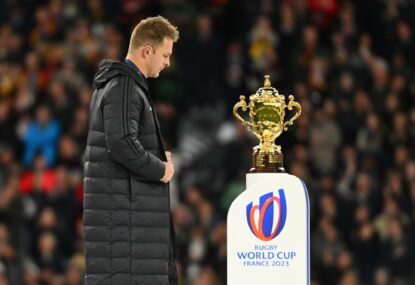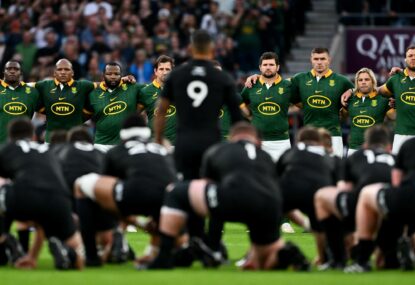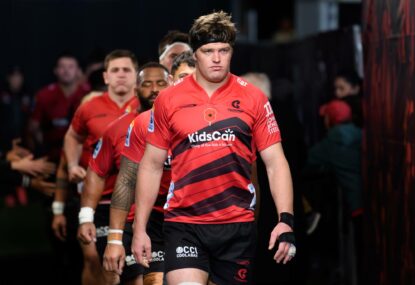The Wallabies met Samoa for the first time at Pontypool during the 1991 World Cup, but the rugby connections between the two nations are far older, reaching back to 1925 when a now long-forgotten Sydney schoolboy of Samoan blood won Test selection.
Australian players of Pacific Island ancestry are now commonplace. In today’s match Wallabies winger Digby Ioane – New Zealand-born and of Samoan heritage – plays a Samoa XV chosen from a squad that includes his nephew Ole Avei and cousin Andrew Lulua.
Amongst the All Blacks’ history the modern rise of Samoan impact began with superstar Bryan Williams during the 1970 tour of South Africa (scoring 14 tries in his 13 appearances on the wing).
Less known is that the first Samoan-born footballer to play for the All Blacks was as long ago as 1931, with the selection of Ponsonby loose forward Frank Solomon in the team that won the first ever Bledisloe Cup series.
Anyone suggesting that Australia could cite an earlier example of a Samoan-born player among its list of internationals back to 1899 would be presumed to have to put their head into one too many scrums, right? Wrong!
Ernest John Reid gained three Tests caps against the All Blacks in 1925. These were actually New South Wales versus New Zealand matches, and given there was no Queensland Rugby Union in existence at the time, they have retrospectively been recognised by the Australian Rugby Union as full Test internationals.
Some may quibble over this – the New Zealand Rugby Union don’t regard the 1920-26 games versus the Waratahs as Tests – but that shouldn’t diminish Reid’s story.
‘Ernie’ Reid was born in Samoa in 1905. As his name would imply, his father was of Anglo origins, and apparently of some wealth as the operator of a large business, while was mother was “a Samoan lady of high birth.”
Reid was sent to New Zealand in his early teens to board at Auckland’s Sacred Heart College, following in the path of other sons of Samoa’s wealthier families. While little is known of his academic achievements, he is reputed to have had three seasons in the school’s First XV.
The decision was made to complete his schooling at St Joseph’s College in Sydney (in time his three younger brothers would follow). Through 1923 Reid and his team made a significant impact on the city’s rugby scene, particularly given the profile enjoyed by GPS matches at that time (a consequence of the paucity of clubs and players that existed at the adult level).
This was a season revered in Australian rugby folklore as the beginning of the Brother Henry (Francis Gaffney) coaching era at St Joseph’s. One of the college’s greatest ever teams – with the emphasis on ‘team’ – it won the premiership amassing 250 points to 25 in the seven games.
One student later recalled this XV as playing with “the most unselfish motives that ever pulled on sprigged boots.”
Another contemporary later recalled specifically of Reid: “Ernie brought to the austere life of boarding school all the exotic glamour of his native environment. Of perfect physique, weighing nearly 13 stone and over six feet in height, he did everything with a flashing smile and a little grace that set him apart!”
Reid played in the centres, possessed blistering pace, and a prodigious kick of the football – off either foot. His size and fine proportions gave him another substantial advantage over his opponents. As one witness of Reid in action put it, “He went at a pace surprising for so big a man, relying on speed and weight to carry him through the tacklers.”
In 1925 Reid was still attending St Joseph’s but, but now 19 years old, was barred from playing in the school competition, and turned to the local club scene.
His talents were no secret to the secretaries of the various Sydney clubs, and he joined Glebe-Balmain (now Drummoyne), which went on to win that season’s premiership (now Shute Shield).
Despite still being at school, and with limited first grade appearances, Reid made such an impression that in mid-June 1925 he was chosen as a reserve back for the first Test against the visiting All Blacks.
The New Zealanders routed the home side 26-3. Reid and host of other promising players were given a chance to shine in a mid-week ‘NSW XV’ game versus the New Zealanders at University Oval.
Reid’s moment had come – he took the opportunity in mesmerising style, scoring three tries, setting up another, and using his powerful kick to pen the All Blacks in their own half.
The result was an upset 18-16 victory to the Light Blues of NSW, and the selectors rewarded all but two of the side with a place in the second Test team, including Reid at inside centre.
A hard, close-fought battle dominated by both forward packs was decided in favour of the All Blacks 4-0 via a solitary drop goal.
Reid was rated among the best of the home side’s backs, but was criticised for his choice at the end of a long run to punt the ball ahead, instead of opting to pass to an unmarked support that ultimately may have won the day.
The final Test was played in atrociously bad weather, and while a late charge-down try gave the visitors an 11-3 win, Reid was praised for his long kicks that again hemmed the opposition in their own territory for long periods.
Reid scored a runway try from halfway in yet another NSW-NZ game, this time at Newcastle, securing a place in the touring squad to visit New Zealand at the end of the season.
He was no longer an unknown quantity though, and throughout the tour was ‘spotted’ heavily by opposition defences. The schoolboy though ended the campaign with a further Test appearance to his credit and a tour tally of five tries.
Shortly before the now legendary 1927-28 Waratahs touring team to the UK was chosen, Reid severely injured his back while in the surf at a Sydney beach.
The prognosis was so dire that he was told he would no longer be capable of walking. Though his all too brief football career was now obviously over, Reid defied the odds and “made an amazing recovery.” He returned home to Samoa, taking over as manager of his father’s business.
Sadly, in April 1938, the now 32-year-old Reid suffered an attack of pneumonia.
It was so severe that it overwhelmed his body and he passed away. It is a measure of Reid’s popularity in Sydney that, a decade on from his last game, the announcement of his untimely and tragic death was headline news in The Sydney Morning Herald.
Ernie Reid’s legacy may well be the rise of rugby in Samoa.
In the early 1920s the code wasn’t played by native Samoans, with football the preferred game, apparently upon the basis that rugby’s hard tackling would inevitably trigger fights. No doubt Reid, from personal experience, could offer a counter view.
It is known that Reid returned home to Samoa from St Joseph’s each summer holidays, and that in November 1924 a rugby game was played in Apia (the capital) against a team from Fiji.
That game, won 6-0 by the visitors, is now regarded as Samoa’s first international.
Article compiled from research by Sean Fagan, Paul Neazor, and Max Howell


































































































